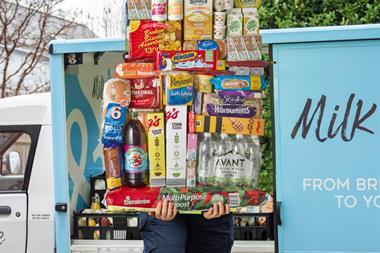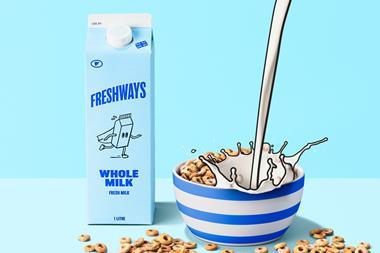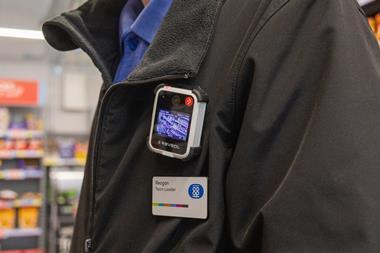The butters and spreads market may be mature, but manufacturers and retailers insist this longevity does not preclude opportunity for growth or act as a bar to consumer interest.
And, as good as their word, retailers and core brands are working together to enhance category management efficiency and exploit the potential for growth that they say is there for the taking.
One of those suppliers, Arla Foods Fonterra, is working with the major multiples to create new category definitions aimed at clarifying the fixtures for shoppers.
They say that consumers are bewildered by the plethora of products on shelf with no clear points of distinction.
Marcus Farthing, Arla's senior category manager, says Arla's segmentation trial will use divisions that are logical to consumers: Natural Taste, Family everyday, Health & Well being, and Cooking & Baking.
"The model will potentially cut the fixture to 20% of the brands displayed there now and focus on high value areas such as olive oil spreads and spreadables."
Matthews Foods, yellow fats category champion in The Grocer's last survey of own label suppliers, agrees that to grow the market category definitions must be ones that first and foremost make sense to customers.
Marketing director Dave Coulson says there needs to be a change in the approach to segmentation, with the focus on the shopper and the retailer, not on divisions between branded or own label.
He adds:"We've worked with retailers on an extensive study of yellow fats, covering attitude and usage and the psychology of buying."
Coulson believes that this approach would be more effective in driving sales than promotions and low pricing strategies.
Lactalis UK marketing manager Stephen Hull speaks for the majority of manufacturers when he says that labelling is another factor that alienates consumers at the fixture.
"We've seen the draft proposals for EC labelling regulations which cover the need for clearer nutritional, functional and health claims, and we subscribe to that," he says. "There need to be EU-wide guidelines so the issues are clear once and for all."
According to Taylor Nelson Sofres Superpanel, the yellow fats market is worth £776m and is showing 1% year-on-year value growth while volume is declining.
The increase, while small, seems to vindicate all the work that is being done with premium, functional and speciality sectors.
Functional spreads are worth £56m with a 9% year-on-year value growth [TNS]. The two top brands are Flora Pro-activ and Benecol.
And the major multiples have seized on the trend towards speciality butters in the last year by launching regional own labels.
While speciality and functional products may command the best margins, spreadable butters show the biggest growth.
TN Sofres Superpanel reports that spend on spreadables has increased 30% over the past year, driven by Lurpak and Anchor. The sector now represents 13% of yellow fats.
The demand for convenience which has driven the development of spreadable butters has continued to keep dairy spreads popular.
According to TNS Superpanel data, it is the second largest yellow fats sector after butter, growing at 7% by value.
Of the top sellers in the yellow fats market as a whole, five are spreads and conform to the growing trend towards larger, 500g packs. Unilever Bestfoods' I Can't Believe It's Not Butter holds a 4.2% share, Dairy Crest's Clover a 4% share, Unilever's Flora Light is in third position at 3.7%, Flora Original fourth at 3.5% and Dairy Crest's Utterly Butterly has a 3.2% share [ACNielsen 16 weeks to Sept 7].
Arla's Anchor block butter 250g is up among the spreads, sitting at number six in the entire yellow fats market. Senior brand manager Mikael Horsboll has great hopes for the brand's future. The relaunch, which began in August, will help to build sales, he says, as will Arla's increased focus on spreadables, such as new packaging for Anchor Spreadable and, in the longer term, new product development which will include butter-based products.
The need for convenience is one reason for butter's decline, as Unilever category manager Jonathan Bedford explains: "Declining consumption of bread at breakfast, increased out of home eating and the demise of home baking are all contributing."
However, where consumers use block butter for cooking, manufacturers have noted that they want high quality and taste.
Arla has seen this as an opportunity to add value and has launched a range of Lurpak branded flavoured butters in garlic, lime and chilli, and Mediterranean herb flavours, primarily for the consumer to use in food preparation.
{{FOCUS ON }}
And, as good as their word, retailers and core brands are working together to enhance category management efficiency and exploit the potential for growth that they say is there for the taking.
One of those suppliers, Arla Foods Fonterra, is working with the major multiples to create new category definitions aimed at clarifying the fixtures for shoppers.
They say that consumers are bewildered by the plethora of products on shelf with no clear points of distinction.
Marcus Farthing, Arla's senior category manager, says Arla's segmentation trial will use divisions that are logical to consumers: Natural Taste, Family everyday, Health & Well being, and Cooking & Baking.
"The model will potentially cut the fixture to 20% of the brands displayed there now and focus on high value areas such as olive oil spreads and spreadables."
Matthews Foods, yellow fats category champion in The Grocer's last survey of own label suppliers, agrees that to grow the market category definitions must be ones that first and foremost make sense to customers.
Marketing director Dave Coulson says there needs to be a change in the approach to segmentation, with the focus on the shopper and the retailer, not on divisions between branded or own label.
He adds:"We've worked with retailers on an extensive study of yellow fats, covering attitude and usage and the psychology of buying."
Coulson believes that this approach would be more effective in driving sales than promotions and low pricing strategies.
Lactalis UK marketing manager Stephen Hull speaks for the majority of manufacturers when he says that labelling is another factor that alienates consumers at the fixture.
"We've seen the draft proposals for EC labelling regulations which cover the need for clearer nutritional, functional and health claims, and we subscribe to that," he says. "There need to be EU-wide guidelines so the issues are clear once and for all."
According to Taylor Nelson Sofres Superpanel, the yellow fats market is worth £776m and is showing 1% year-on-year value growth while volume is declining.
The increase, while small, seems to vindicate all the work that is being done with premium, functional and speciality sectors.
Functional spreads are worth £56m with a 9% year-on-year value growth [TNS]. The two top brands are Flora Pro-activ and Benecol.
And the major multiples have seized on the trend towards speciality butters in the last year by launching regional own labels.
While speciality and functional products may command the best margins, spreadable butters show the biggest growth.
TN Sofres Superpanel reports that spend on spreadables has increased 30% over the past year, driven by Lurpak and Anchor. The sector now represents 13% of yellow fats.
The demand for convenience which has driven the development of spreadable butters has continued to keep dairy spreads popular.
According to TNS Superpanel data, it is the second largest yellow fats sector after butter, growing at 7% by value.
Of the top sellers in the yellow fats market as a whole, five are spreads and conform to the growing trend towards larger, 500g packs. Unilever Bestfoods' I Can't Believe It's Not Butter holds a 4.2% share, Dairy Crest's Clover a 4% share, Unilever's Flora Light is in third position at 3.7%, Flora Original fourth at 3.5% and Dairy Crest's Utterly Butterly has a 3.2% share [ACNielsen 16 weeks to Sept 7].
Arla's Anchor block butter 250g is up among the spreads, sitting at number six in the entire yellow fats market. Senior brand manager Mikael Horsboll has great hopes for the brand's future. The relaunch, which began in August, will help to build sales, he says, as will Arla's increased focus on spreadables, such as new packaging for Anchor Spreadable and, in the longer term, new product development which will include butter-based products.
The need for convenience is one reason for butter's decline, as Unilever category manager Jonathan Bedford explains: "Declining consumption of bread at breakfast, increased out of home eating and the demise of home baking are all contributing."
However, where consumers use block butter for cooking, manufacturers have noted that they want high quality and taste.
Arla has seen this as an opportunity to add value and has launched a range of Lurpak branded flavoured butters in garlic, lime and chilli, and Mediterranean herb flavours, primarily for the consumer to use in food preparation.
{{FOCUS ON }}



















No comments yet